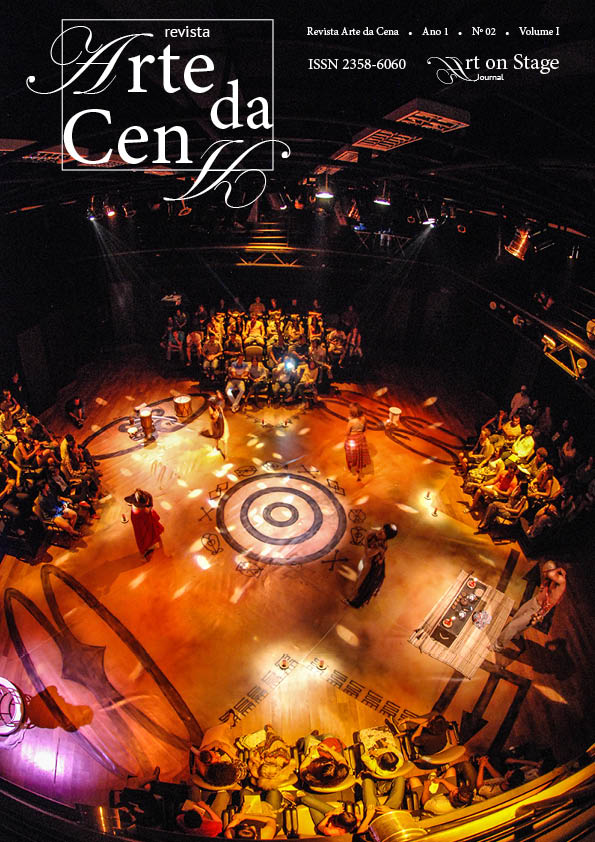Dancing the Flesh: The Adam Myth in Scene
Keywords:
Dança, Mito, Criação, Corpo.Abstract
This article offers a reflection about the human condition revealed in myths, which in its symbolic potential, serves us as an impetus to think about the existence, the body, and create artistically in contemporary dance under the perspective of the phenomenological attitude that proposes the French philosopher Merleau-Ponty. This is an account of creation lived with Aviva Cia de Dança, process that culminated in the artistic and choreographic work “A Carne que Sou”, and that inspired in the myth of Adam, breathe its own senses to each body that created that dance, unleashing possibilities to think the creations and artistic works as advisors in ontological and epistemological reflections.Downloads
References
Bíblia de estudos de Genebra. São Paulo e Barueri, Cultura Cristã e Sociedade Bíblica do Basil,1999.
CAMPBELL, Joseph; MOYERS, Bill D; FLOWERS, Betty S. O poder do mito. 20 ed. São Paulo: Palas Athena, 2002.
COLLODI, Carlo. Pinóquio. Tradução de Ana Carolina Oliveira e Renato Avelar Gomes. Belo Horizonte: Dimensão, 2008.
DURAND, Gilbert. As Estruturas antropológicas do imaginário: introdução a arquetipologia geral. São Paulo: Martins Fontes, 1997.
ELIADE, Mircea. Mito e realidade. São Paulo: Editora Perspectiva, 1972.
JUNG, C. G. Símbolos da transformação. Petrópolis: Vozes. 1986.
____. Aion: estudos sobre o simbolismo. Rio de Janeiro: Vozes, 1982.
LEAL, Patrícia Garcia. Amargo perfume: A dança pelos sentidos. Tese de doutorado, Campinas, SP, 2009.
MENDES, Maria Isabel Brandão de Souza. Corpo e cultura de movimento: Cenários epistêmicos e educativos. Curitiba: Editora CRV, 2013.
_____. NOBREGA, Terezinha Petrucia da. Corpo, natureza e cultura: contribuições para a educação. Rev. Bras. Educ. [online]. 2004, n.27, pp. 125-137.
MERLEAU-PONTY, Maurice. Fenomenologia da percepção. Tradução de Carlos Alberto Ribeiro de Moura. São Paulo: Martins Fontes, 1994.
____. A natureza: notas: cursos no Collège de France. São Paulo: Martins Fontes, 2000. Tradução de Álvaro Cabral.
____. O olho e o espírito. Tradução Paulo Neves e Maria Ermantina Galvão Gomes Pereira. São Paulo: Cosac Naify, 2004.
____. O Visível e o Invisível. 3a ed. São Paulo: Editora Perspectiva, 1992
NÓBREGA, Terezinha Petrucia da. Uma fenomenologia do corpo. São Paulo: Editora Livraria da Física, 2010.
____. Para uma teoria da corporeidade: Um diálogo com Merleau-Ponty e o pensamento complexo. Tese de doutorado, Piracicaba, SP, 1999.
NUNES, Benedito. Physis, Natura - Heidegger e Merleau-Ponty. Nat. hum., São Paulo , v. 6, n. 2, dez. 2004 . Disponível em <http://pepsic.bvsalud.org/scielo.php?script=sci_arttext&pid=S1517 24302004000200004&lng=pt&nrm=iso>. acessos em 06 abr. 2014.
SERBENA, Carlos Augusto. Considerações sobre o inconsciente: mito, símbolo e arquétipo na psicologia analítica. Rev. abordagem gestalt. [online]. 2010, vol.16, n.1, pp. 76-8
Downloads
Published
How to Cite
Issue
Section
License
Copyright (c) 2023 Luiz Felipe Ferreira da Rocha

This work is licensed under a Creative Commons Attribution-NonCommercial 4.0 International License.
The Art on Stage Journal uses the Creative Commons - Attribution-Non-Commercial 4.0 International license as a basis for transferring rights, for open access journals (Open Archives Initiative - OAI).
Authors who publish in this journal agree with the following terms:
1) Authors retain the copyright and grant the Art on Stage Journal the right to first publication, with the work simultaneously licensed under the Creative Commons Attribution Non Commercial License.
2) Authors are authorized to assume additional contracts separately, for non-exclusive distribution of the version of the work published in this Journal (eg, publishing in institutional repository or as a book chapter), with acknowledgment of authorship and initial publication in this journal.
3) Authors are allowed and encouraged to publish and distribute their work online (eg in institutional repositories or on their personal page) at any point before or during the editorial process, provided that the reference to the place of publication is cited, that is, the electronic address / reference of Art on Stage Journal.
4) The authors of the works published in the Art on Stage are expressly responsible for their content.
5) Authors will not be paid for publication of works in the Art on Stage Journal.



